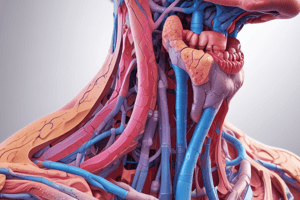Podcast
Questions and Answers
What is the pathogenesis of simple goitre?
What is the pathogenesis of simple goitre?
- Involution of follicular cells
- Repeated cycles of iodine deficiency and correction
- ↑ hormone synthesis + ↑ TSH Hyperplasia
- Symmetrical diffuse enlargement of follicular cells (correct)
Which type of goitre is characterized by asymmetrical, nodular enlargement and irregular thyroid surface?
Which type of goitre is characterized by asymmetrical, nodular enlargement and irregular thyroid surface?
- Multinodular goitre (correct)
- Colloid goitre
- Simple goitre
- Toxic goitre
What is the characteristic microscopic feature of multinodular goitre?
What is the characteristic microscopic feature of multinodular goitre?
- Diffuse enlargement of thyroid follicles
- Follicles lined by flat cells and filled with colloid
- Variable sized nodules separated by fibrous tissue (correct)
- Enlargement of follicular cells
What can repeated cycles of iodine deficiency and correction lead to in the thyroid?
What can repeated cycles of iodine deficiency and correction lead to in the thyroid?
What is the primary cause of non-toxic endemic goitre?
What is the primary cause of non-toxic endemic goitre?
Which type of goitre is mostly caused by impaired thyroid hormone synthesis due to iodine deficiency?
Which type of goitre is mostly caused by impaired thyroid hormone synthesis due to iodine deficiency?
What is the primary pathogenesis of diffuse colloid (simple) goitre?
What is the primary pathogenesis of diffuse colloid (simple) goitre?
Which factor is a common cause of sporadic non-toxic goitre in young females?
Which factor is a common cause of sporadic non-toxic goitre in young females?
What is the specific feature of Graves disease that distinguishes it from other causes of hyperthyroidism?
What is the specific feature of Graves disease that distinguishes it from other causes of hyperthyroidism?
Which of the following is a characteristic feature of Hashimoto’s thyroiditis?
Which of the following is a characteristic feature of Hashimoto’s thyroiditis?
What is the distinguishing feature of Subacute Granulomatous Thyroiditis?
What is the distinguishing feature of Subacute Granulomatous Thyroiditis?
Which neoplastic condition is associated with the development of goitre?
Which neoplastic condition is associated with the development of goitre?




